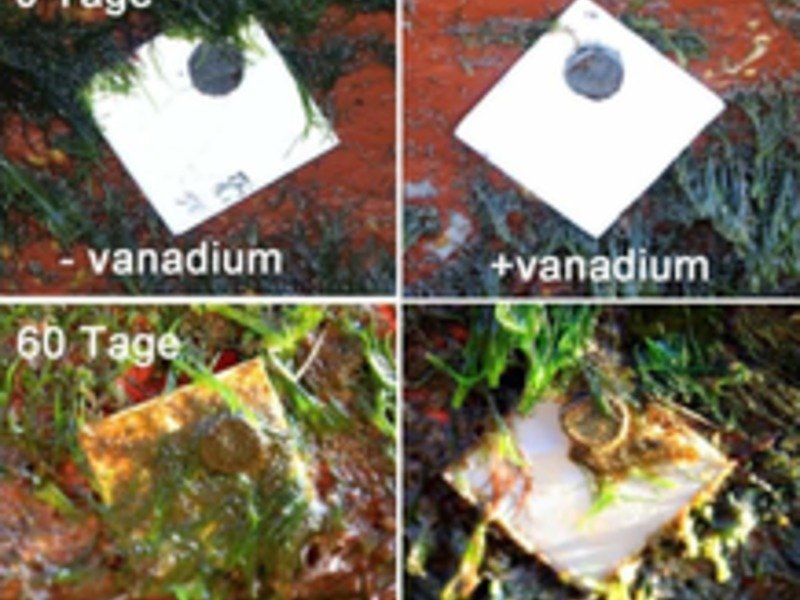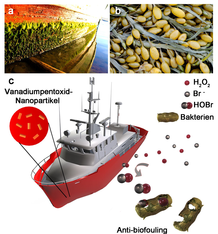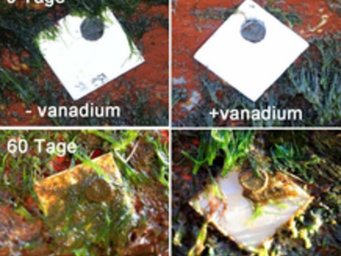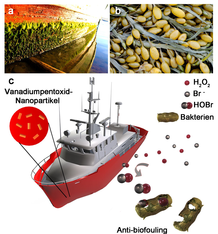New method against marine fouling discovered
Researchers of the Max Planck Institute for Chemistry tested the environmental compatibility of bactericidal agent nanoparticles in ship coatings
The abundant growth of algae, bacteria and barnacles on hulls could soon be finished in an environmentally friendly manner. Researchers of the Johannes Gutenberg-University led by Professor Wolfgang Tremel from the Institute of Inorganic Chemistry and Analytical Chemistry have found a way to mimic the natural defense mechanism of brown and red algae, in order to prevent marine fouling. These algae contain certain enzymes that generate the halogenated compounds which act as biocides. The same effect is imitated by the scientists using vanadium pentoxide nanoparticles dispersed in various coatings.

Their experiments showed that steel plates to which a coating containing dispersed vanadium pentoxide particles had been applied could be exposed to seawater for weeks without the formation of deposits of barnacles, bacteria, and algae. In comparison, plates that were coated only with the ship's normal paint exhibited massive fouling after exposure to seawater for the same period of time.
A research group headed by Dr. Klaus Peter Jochum of the Max Planck Institute for Chemistry in Mainz has been conducting experiments to determine whether the use of vanadium pentoxide might have a negative effect on the environment. Using a highly sensitive ICP mass spectrometer, the scientists determined the concentration of vanadium in various samples of seawater that had been exposed to the coated material for different lengths of time. The results showed that levels were only slightly elevated above the normal average vanadium concentration in seawater. It can thus be concluded that only very tiny amounts of vanadium migrate from the coating into seawater and will thus have no negative impact on the environment.
Marine fouling is a problem that costs the shipping industry more than 200 billion dollars per year. The accumulation of organisms such as algae, mussels, and barnacles increases the objects’ water resistance and, in consequence, fuel consumption. This means additional costs for shipping companies and, even worse, increased environmental damage due to extra CO2 emissions. Within only a few months, an underwater boat hull can be completely covered and overgrown with organisms. According to Lloyds, this means an increase in fuel consumption of up to 28 percent and about 250 million tons of additional CO2 emissions per year. While it is possible to counteract this effect to some extent by means of the use of antifouling paints, conventional biocides are less effective and can have adverse environmental consequences. In addition, microorganisms can develop resistance to them.
Inspired by nature
Certain enzymes found in brown and red algae produce halogen compounds that have a biocidal potential. It is assumed that these are synthesized by the algae to protect them against microbial attack and predators. The chemists at Mainz University decided to mimic this process using vanadium pentoxide nanoparticles. According to their article published in Nature Nanotechnology, vanadium pentoxide (V2O5) nanoparticles have "an intrinsic biomimetic bromination activity […] which makes them a practical and cost-efficient alternative for conventional chemical biocides." Vanadium pentoxide functions as a catalyst so that hydrogen peroxide and bromide combine to form small quantities of hypobromous acid, which is highly toxic to many microorganisms and has a pronounced antibacterial effect. The required reactants are present in seawater: This already contains bromide ions, while small quantities of hydrogen peroxide are formed when it is exposed to sunlight.

